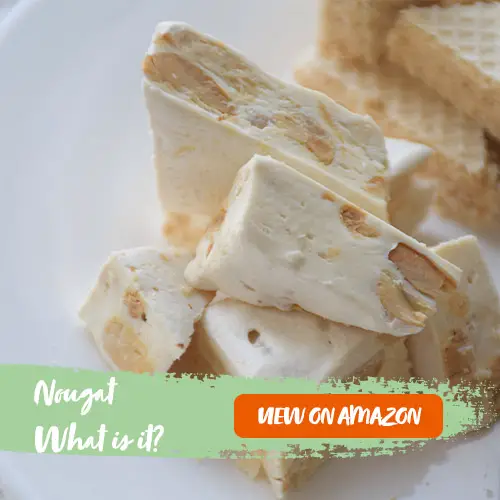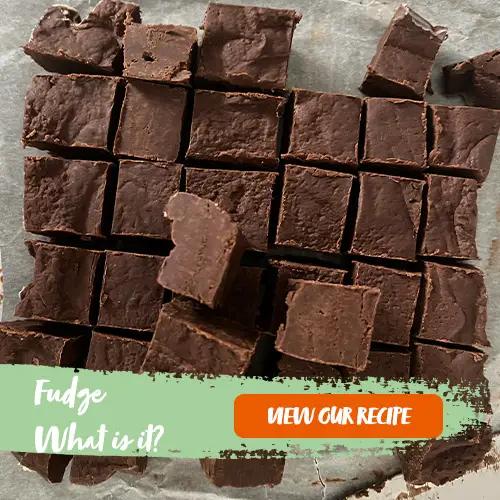When it comes to sweet treats, there are few confections as airy, delicate, and satisfying as nougat and fudge. Both of these sweets have a confectionery consistency when combined with a smooth and chewy texture makes for a delicious dessert. But what are the differences between nougat and fudge?
The primary difference between nougat and fudge is that nougat has elements of honey, fruit, and nuts inside of a sugary paste. Fudge, on the other hand, is made from sugar, cream or chocolate mixed with a few basic ingredients. Both confectionaries have a similar consistency but taste and look differently.
In this guide, we will break down all the differences between nougat and fudge. We will also take a look at different kinds of nougat and fudge, as well as explore some of their similarities.
Read on to find out more.

What exactly is nougat?
Almond nougat, brown nougat, soft nougat, French nougat, Persian nougat, Viennese nougat, and white nougat; all of these types of nougat taste differently, but still maintain the basic elements of what makes nougat.
Nougat is a French word for a candy substance that is made with a whipping agent that blends nuts, sugar, honey, and/or fruit together in an aerated consistency.
Like fudges, nougat is then allowed to set and harden before being consumed or more popularly, used as an additive in a wide variety of sweet confections. A nougat mixture can also contain other ingredients that can be used to make many of the types I mentioned above.
The two primary types of nougat are brown and white-colored, and nearly all varieties come in either hard or soft. The beaten egg whites into stiff peaks are what give nougat its crunchy texture.
With this in mind, how is nougat made?
How is nougat made?
Although nougat looks similar to a variety of fudges before it sets, the process for making this confection can be quite time-consuming.
Honey, toasted almonds, egg whites, and sugar are needed for the base of nougat. Some variations include finely ground hazelnuts or other roasted nuts like pistachios, walnuts, peanuts, and pralines in place of almonds, and many of these variations can sometimes be seen during the making of candy bars.
Also, a brown nougat will also feature a different recipe model than the standard recipes used to make white nougat.
Nougat is made by first mixing honey or corn syrup along with sugar and egg whites until a homogenous mass is achieved. After this, the nuts are then added to the mix as well as any sweet fruits, and the mixing process is increased to create the consistency needed.
After this is complete, the nougat is then sectioned off into molds where it is then chilled to firmly set into place. The nougat can then be sliced or packaged accordingly.
Nougat recipes vary greatly across the world. France, Italy, and the Middle East all have specific varieties. In Italy, Italian nougat is distinct in that it features strong hints of lemon or orange from citrus peels.
No matter what region it is from, nougat is always a wonderfully delicious treat to eat.

What makes fudge fudge?
Varieties of fudges are a type of sugar candy that features milk, cream, sugar and sweetened condensed milk or different variations of these ingredients such as chocolate pieces, cream, or caramel depending on the flavors desired. Almond or hazelnuts can also be used in fudges making the recipe a bit similar to nougat.
Fudges are a bit softer and less creamy than nougat and this is largely due to the lack of egg whites. Nougat de Montelimar from the Mediterranean region of France is a softer variety of nougat similar to fudge.
So, how exactly are fudges made?
Find out more about what fudge is here.
How is traditional fudge made?
These recipes stretch far and wide, but traditional chocolate fudges are by far the most commonly prepared in kitchens and homes across the world.
The ingredient list is fairly simple. Sugar, butter, and sweetened condensed milk are melted down in a pan. A candy thermometer works wonders for ensuring the cooking process does not exceed 240 degrees Fahrenheit.
After the temp is reached, chocolates of choice, vanilla extract for added flavor, and nuts (try hazelnuts next time) are then added to the mix.
Then, you simply pour the filling into a pan lined with parchment paper and allow the mix to set for at least a few hours to be completely firm.
What are the similarities between nougat and fudge?
Some of the similarities between the two desserts are that both have a cream-like appearance and form and are delectable – obviously!
Both desserts are also similar in how they must be set for a substantial amount of time to ensure the desserts maintain the proper firmness.
What are the differences between nougat and fudge?
Nougat is not cooked quite as long, whereas fudges are cooked to a substantial temperature to ensure the ingredients all meld together. Nougat is distinctive in how the wholeness of the ingredients is on full display whereas fudge is more of a complete and uniform taste.
FAQs
Is nougat a marshmallow?
Nougat is very similar to marshmallows, but it is different in terms of its ingredients and final texture. It is more similar to divinity than marshmallows.
Why is it called nougat?
Nougat is derived from Latin and roughly translates to “nut bread.” This is easy to see since this dessert is quite nutty and is typically shaped in the same form as bread.
How do you pronounce nougat?
Nougat is pronounced differently depending on where you are in the world. In the United States, it is pronounced “new-get,” and in the UK, “nooo-gat.”
In summary
As you can see, there are some distinct differences between nougat and fudge. But there are also some similarities between the two desserts. Both are fairly easy to make, and nougat, in particular, is used as a filling for a variety of different candies.
Want to find out more about fudge? We recommend you read these:


